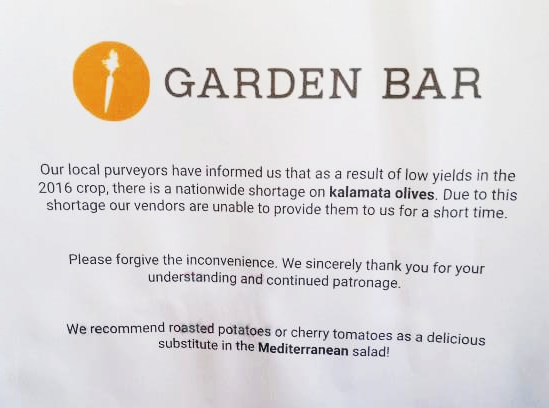I think that it’s usually fairly difficult for us to imagine what will happen in the future with climate change. Especially since we humans have a particularly hard time grasping concepts related to large changes over long periods of time. What does “1 million years ago” even mean? What was even happening then? Apparently, our common ancestor with Neanderthals was roaming around. Humans were definitely not around yet.
So here is a notice I found at a restaurant in Portland, OR:
A nationwide shortage of Kalamata olives? Who could have known about that? Looks like the world is or will be experiencing a shortage of olive products soon. It seems to be due to erratic weather combined with disease and increased demand. Fairly normal for an agricultural product to go through ups and downs. But what does the future hold for olives?
From published scientific research, it appears that it’s a mixed bag. Some olives will be winners while others will lose out. Other research suggests that the success of certain Mediterranean crops will hinge on water availability.
This is a common story with plants and climate change. As some regions become inhospitable for a given crop/species, other regions become more amenable to growing these species. For crop plants, it’s relatively easy to transition them from one region to another.
It’s a completely different story for native plant species. Native plants are limited in their ability to redistribute themselves across the landscape, and will have a much more difficult time shifting ranges under a rapidly changing climate. Many native plants are dispersal-limited, meaning that they have a tough time moving their seeds far distances or to favorable locations.
Luckily, there is some hope: Some plant species shifts have already been observed to occur in recent years. Nature is a complicated thing, both resilient and fragile simultaneously.
Stay tuned for more musings on what will be #ClimateChanged next month.


